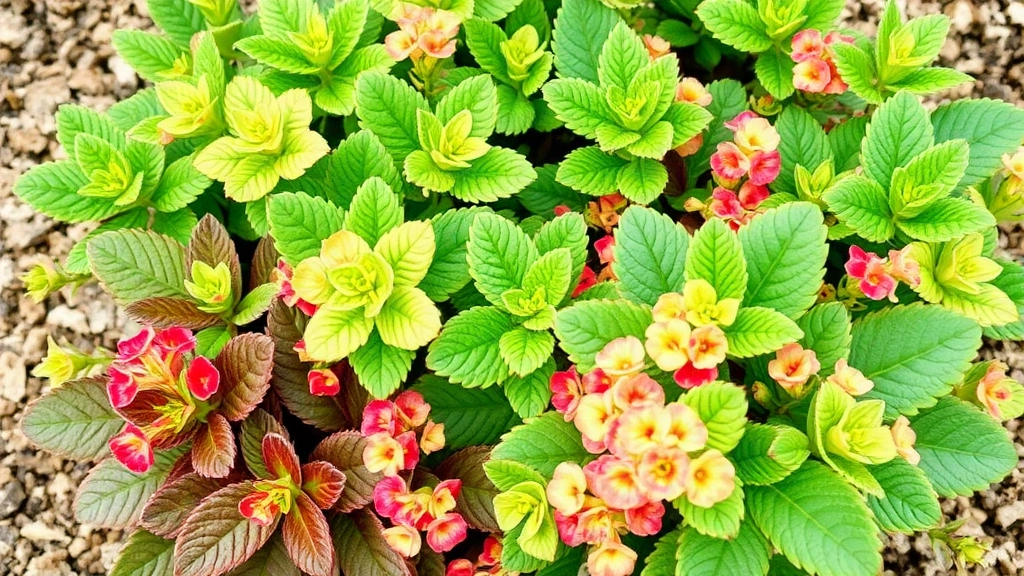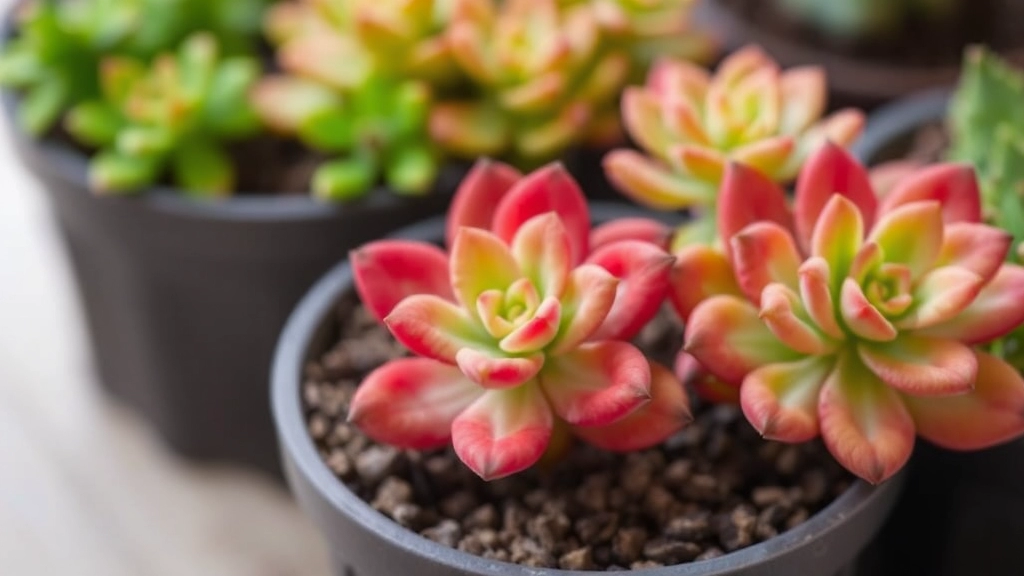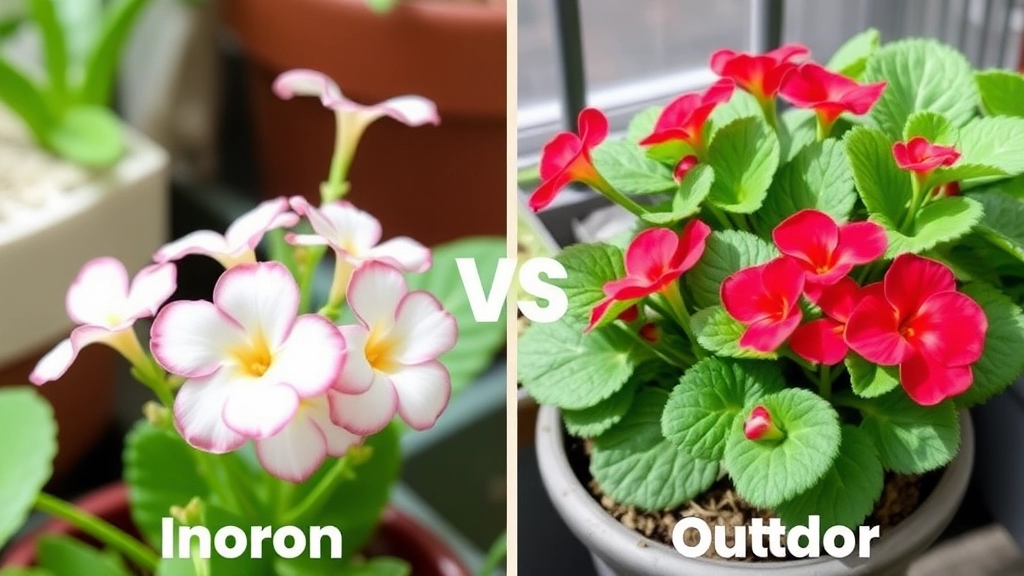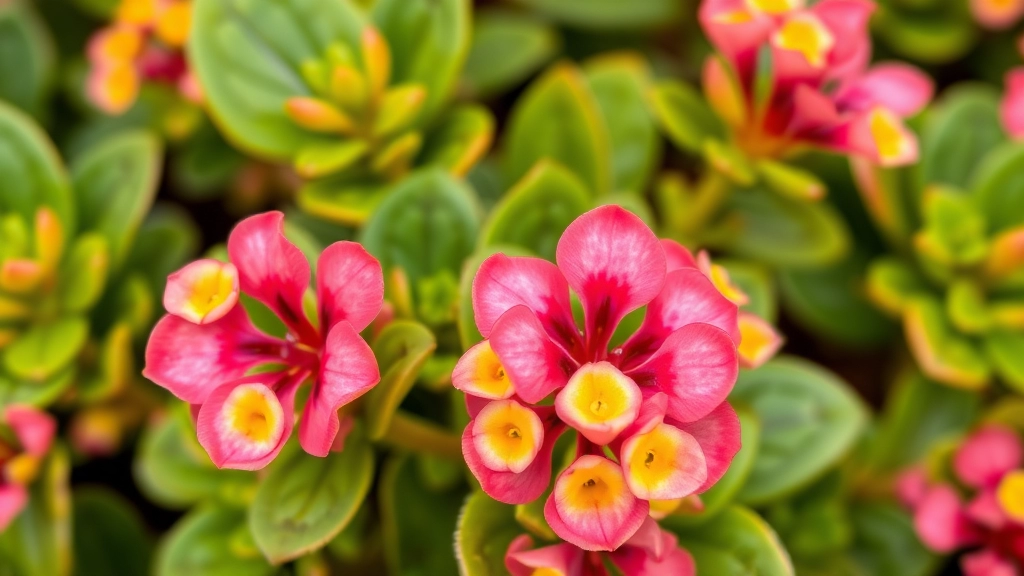Exploring Kalanchoe Species
When it comes to flowering plants, the Kalanchoe species stand out for their vibrant blooms and easy care. In this article, we’ll explore popular flowering Kalanchoe species, unique foliage varieties, and essential care tips to keep your plants thriving. Whether you’re a seasoned gardener or a beginner, you’ll find valuable insights on propagation techniques, common pests, and indoor vs. outdoor growing conditions.
Understanding Kalanchoe Types
Understanding the different types of Kalanchoe can help you choose the best plants for your space. We’ll also cover important safety tips, including toxicity concerns, to ensure a safe environment for everyone in your home.
Dive In
Dive in to discover everything you need to know about Flower Kalanchoe Species and how to cultivate them successfully.
Popular Flowering Kalanchoe Species
When it comes to selecting the right flowering Kalanchoe species, many gardeners often feel overwhelmed by the variety available.
Kalanchoe Blossfeldiana
This species is perhaps the most recognised.
- Known for its vibrant blooms in shades of red, pink, yellow, and white.
- Typically, it flowers in clusters, creating a stunning display.
- Ideal for indoor pots or as a gift, especially during festive seasons.
Kalanchoe Tomentosa
Also known as the ‘Panda Plant’, it features soft, fuzzy leaves.
- While not primarily known for its flowers, it does produce delicate yellow blooms.
- Its unique foliage makes it a popular choice for succulent collections.
Kalanchoe Fedtschenkoi
This species stands out for its charming, scalloped leaves.
- It produces clusters of small, tubular flowers, usually in shades of pink.
- A fantastic option for hanging baskets, adding a delightful touch to any space.
Kalanchoe Laxiflora
A lesser-known gem, this species offers a unique twist.
Unique Foliage Varieties of Kalanchoe

So, you’ve got a soft spot for Kalanchoe, right? It’s not just about those vibrant blooms; the foliage can be just as stunning!
When we talk about unique foliage varieties of Kalanchoe, we’re diving into some real eye-catchers. These plants aren’t just about flowers; their leaves can steal the show too. Let’s explore some of these captivating varieties that can add flair to your plant collection.
1. Kalanchoe luciae (Paddle Plant)
- Shape: The leaves are thick and paddle-shaped, resembling a succulent lily pad.
- Colour: They often have a lovely reddish edge, especially when exposed to bright sunlight.
2. Kalanchoe tomentosa (Panda Plant)
- Texture: These leaves are covered in soft, fuzzy hairs.
- Look: They have a striking silvery-green colour with dark brown edges, making them feel like a cuddly plant buddy.
3. Kalanchoe beharensis (Felt Plant)
- Size: The leaves can grow quite large, often reaching up to 30 cm long!
- Feel: They have a felt-like texture, adding a unique touch to your plant display.
4. Kalanchoe orgyalis (Copper Spoons)
- Appearance: The leaves are thick and spoon-shaped, with a lovely coppery hue.
- Highlight: They look stunning in bright light, almost glowing!
5. Kalanchoe marnieriana (Mother of Thousands)
- Feature: This variety produces tiny plantlets along the leaf edges, creating a cascading effect.
- Growth: It’s a real conversation starter and a great way to share your Kalanchoe love with friends!
These unique foliage varieties not only enhance your indoor garden but also bring a touch of personality to your space.
How to Care for Different Kalanchoe Types
Caring for Kalanchoe plants can be a rewarding experience, but it often raises questions. How do I ensure my Kalanchoe thrives? What specific needs do different types have?
General Care Guidelines
Regardless of the species, Kalanchoe plants share some essential care requirements:
- Light: Most Kalanchoe thrive in bright, indirect sunlight. Direct sunlight can scorch their leaves.
- Water: Allow the soil to dry out between waterings. Overwatering is a common issue.
- Soil: Use a well-draining potting mix, ideally designed for succulents.
- Temperature: Maintain a warm environment, ideally between 15°C to 25°C.
Caring for Flowering Kalanchoe
Flowering varieties, such as Kalanchoe blossfeldiana, require a bit more attention:
- Fertilisation: Feed with a balanced fertiliser every month during the growing season.
- Pruning: After flowering, prune back the spent blooms to encourage new growth.
- Humidity: These varieties prefer slightly higher humidity levels. Consider misting occasionally.
Caring for Foliage Varieties
For unique foliage types like Kalanchoe thyrsiflora, focus on:
- Light Exposure: They can tolerate more direct sunlight, enhancing their vibrant colours.
- Water Needs: These types can go longer without water, so be cautious not to overwater.
- Temperature Sensitivity: They may need protection from cold drafts, as they are less tolerant of low temperatures.
Special Considerations
- Pot Size: Ensure pots are appropriately sized. A pot that’s too large can lead to excess moisture retention.
- Repotting: Repot every couple of years to refresh the soil and provide more space for growth.
For more detailed tips on caring for specific varieties, check out our complete guide to Harpoon Leaf Kalanchoe care and our Flaming Katy care tips.
Propagation Techniques for Kalanchoe Plants

If you’re looking to expand your Kalanchoe collection or share these stunning plants with friends, propagation is a rewarding and straightforward process.
Why Propagate Kalanchoe?
Many enthusiasts wonder about the best ways to propagate their Kalanchoe plants. Whether you’re concerned about costs or simply want to enjoy more of these vibrant flowers, propagation is the answer.
Methods of Propagation
- Leaf Cuttings
- Select a healthy leaf from the parent plant.
- Allow the cut end to dry for a few hours to form a callus.
- Place the leaf in well-draining soil, ensuring the cut end is buried.
- Water lightly and keep the soil slightly moist until roots develop.
- Stem Cuttings
- Cut a healthy stem about 4-6 inches long.
- Remove the lower leaves to avoid rot.
- Let the cut end dry for 1-2 days.
- Plant the cutting in a pot with cactus mix or a well-draining soil.
- Water sparingly until roots form.
- Offsets or Pups
- Some Kalanchoe varieties produce offsets, small plants that grow at the base.
- Gently separate the pup from the parent plant.
- Replant in a new pot with appropriate soil.
- Water lightly, allowing the soil to dry out between waterings.
Tips for Successful Propagation
- Timing Matters: Spring is the best season for propagation, as plants are actively growing.
- Light Conditions: Place cuttings in bright, indirect light to encourage growth without burning.
- Humidity: Consider using a plastic bag or a humidity dome to maintain moisture levels, especially for leaf cuttings.
Common Pests and Issues in Kalanchoe Cultivation
As we delve deeper into the world of Kalanchoe, it’s essential to address one of the most pressing concerns for any plant enthusiast: pests and cultivation issues.
Kalanchoe plants can be susceptible to various pests and problems that may hinder their growth and vibrancy. Identifying these issues early can make all the difference in keeping your plants healthy and thriving.
Common Pests
1. Aphids
- Small, green or black insects that cluster on new growth.
- They feed on sap, causing leaves to curl and distort.
2. Mealybugs
- White, cottony masses found in leaf axils and on stems.
- They can weaken the plant and lead to sooty mould.
3. Spider Mites
- Tiny, spider-like creatures that thrive in dry conditions.
- They cause stippling on leaves and may produce fine webbing.
4. Scale Insects
- Small, hard bumps on stems and leaves.
- They can be challenging to spot but can cause significant damage.
Common Issues
1. Overwatering
- Kalanchoe prefers well-drained soil.
- Signs include yellowing leaves and root rot.
2. Underwatering
- Leaves may become shrivelled or wrinkled.
- This can lead to stunted growth and poor flowering.
3. Poor Light Conditions
- Insufficient light can cause leggy growth.
- Ideally, Kalanchoe should receive bright, indirect sunlight.
4. Nutrient Deficiency
- Yellowing leaves can indicate a lack of essential nutrients.
- Regular feeding during the growing season can help.
Prevention and Control
To keep your Kalanchoe flourishing, consider these strategies:
- Regular Inspection: Check your plants weekly for signs of pests.
- Proper Watering: Ensure the soil dries out between waterings.
- Optimal Lighting: Place your plants in a bright spot, avoiding direct sunlight.
- Natural Remedies: Use insecticidal soap or neem oil to combat infestations.
By staying vigilant and proactive, you can minimise the impact of pests and issues on your Kalanchoe plants. For more detailed care tips, check out our complete guide on caring for Kalanchoe after flowering. Additionally, if you’re facing specific problems like brown spots, our article on causes and solutions for brown spots on Kalanchoe leaves can provide valuable insights.
Indoor vs. Outdoor Kalanchoe Growing Conditions

So, you’ve got your Kalanchoe, and now you’re wondering where it’ll thrive best—indoors or outdoors?
Let’s break it down.
Indoor Kalanchoe Conditions
Growing Kalanchoe indoors can be super rewarding. Here’s what you need to know:
- Light: They love bright, indirect sunlight. A south-facing window is ideal.
- Temperature: Keep them cozy at around 20-25°C. They’re not fans of cold drafts.
- Humidity: Average indoor humidity works just fine. No need for a humidifier.
- Watering: Let the soil dry out between waterings. Overwatering is a common mistake!
I once had a Kalanchoe that thrived on my kitchen windowsill, soaking up the morning sun. It was a joy to see it bloom!
Outdoor Kalanchoe Conditions
Thinking of taking your Kalanchoe outside? Here’s how to set it up for success:
- Light: They can handle full sun, but too much direct sunlight can scorch the leaves. A spot that gets morning sun and afternoon shade is perfect.
- Temperature: Ideally, keep them in a warm spot, above 15°C. They can tolerate a bit of chill, but not frost.
- Soil: Well-draining soil is a must. Consider a cactus mix for optimal drainage.
- Watering: Just like indoors, let the soil dry out before watering again.
I had a friend who planted hers in a sunny garden bed, and it turned into a vibrant focal point.
The Balancing Act
Whether you choose to grow your Kalanchoe indoors or outdoors, the key is to monitor their environment closely.
Both settings have their perks, but your choice should align with your lifestyle and the specific needs of your Kalanchoe.
Toxicity Concerns and Safety Tips for Kalanchoe
When considering the beauty and charm of Kalanchoe plants, it’s essential to address a critical aspect: their toxicity. Many plant enthusiasts often wonder, “Are Kalanchoe plants safe for my home, especially around children and pets?”
Understanding Kalanchoe Toxicity
Kalanchoe species, particularly Kalanchoe daigremontiana (Mother of Thousands) and Kalanchoe blossfeldiana (Flaming Katy), contain compounds called bufadienolides. These can be harmful if ingested.
Symptoms of Toxicity
If ingested, symptoms may include:
- Nausea
- Vomiting
- Diarrhoea
- Lethargy
- Heart irregularities
Safety Tips
To ensure a safe environment while enjoying your Kalanchoe, consider the following tips:
- Placement: Keep Kalanchoe plants out of reach of children and pets. High shelves or hanging planters are ideal.
- Education: Teach children about the potential dangers of eating non-food plants.
- Alternative Choices: If you have pets that are prone to nibbling on plants, consider non-toxic alternatives like spider plants or Boston ferns.
- Emergency Preparedness: Familiarize yourself with local poison control numbers and have them readily accessible.
By being aware of these toxicity concerns, you can enjoy your Kalanchoe plants without worry. For more information on keeping your pets safe, check out our guide on Kalanchoe toxicity to dogs. Additionally, learn about the symptoms and prevention of Kalanchoe toxicity in cats.
FAQs on Flower Kalanchoe Species
1. What are some unique foliage varieties of Kalanchoe?
Kalanchoe plants are known for their stunning foliage as well as their vibrant blooms. Some unique varieties include:
- Kalanchoe luciae (Paddle Plant): Thick, paddle-shaped leaves with a reddish edge.
- Kalanchoe tomentosa (Panda Plant): Silvery-green, fuzzy leaves with dark brown edges.
- Kalanchoe beharensis (Felt Plant): Large, felt-like textured leaves.
- Kalanchoe orgyalis (Copper Spoons): Spoon-shaped leaves with a coppery hue.
- Kalanchoe marnieriana (Mother of Thousands): Leaf edges produce tiny plantlets.
2. How can I propagate Kalanchoe plants?
Propagating Kalanchoe is straightforward and rewarding. Here are the methods:
- Leaf Cuttings: Select a healthy leaf, let it dry, and plant in well-draining soil.
- Stem Cuttings: Cut a healthy stem, let it dry, and plant in cactus mix or well-draining soil.
- Offsets or Pups: Separate small plants growing at the base and replant them.
3. What tips can ensure successful Kalanchoe propagation?
For successful propagation, consider the following tips:
- Timing Matters: Spring is the best season for propagation.
- Light Conditions: Place cuttings in bright, indirect light.
- Humidity: Use a plastic bag or humidity dome to maintain moisture levels.
4. What are the ideal indoor growing conditions for Kalanchoe?
For indoor Kalanchoe, ensure the following conditions:
- Light: Bright, indirect sunlight is ideal.
- Temperature: Maintain around 20-25°C.
- Humidity: Average indoor humidity is sufficient.
- Watering: Let soil dry out between waterings to avoid overwatering.
5. Can Kalanchoe be grown outdoors?
Yes, Kalanchoe can thrive outdoors under the right conditions:
- Light: They can handle full sun but prefer morning sun and afternoon shade.
- Temperature: Keep them above 15°C and protect from frost.
- Soil: Use well-draining soil, such as a cactus mix.
- Watering: Allow soil to dry out before watering again.
6. Should I grow Kalanchoe indoors or outdoors?
Both indoor and outdoor settings have their perks. Choose based on your lifestyle and the specific needs of your Kalanchoe. Monitor their environment closely for the best results.
References
-
Kalanchoe luciae (Paddle Plant)
-
Kalanchoe tomentosa (Panda Plant)
-
Types of Kalanchoe
